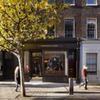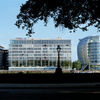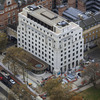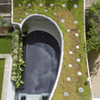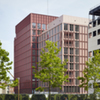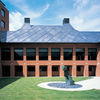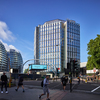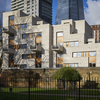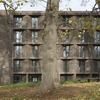De Beauvoir Block
Subscribe now to instantly view this image
Subscribe to the Architects’ Journal (AJ) for instant access to the AJ Buildings Library, an online database of nearly 2,000 exemplar buildings in photographs, plans, elevations and details.
Already a subscriber? Sign in
In the past, the units have served as everything from a print works to makeshift residential units
Nick Kane Download Original
With its scheme for east London’s Benyon Estate, Henley Halebrown has created a melting pot for start-ups and small businesses.
The block houses 33 office spaces, separated into ‘tiers’ ranging from the members’ café and a co-working ‘incubator’ to rentable office space at various floor areas and lease lengths.
During the first phase of the project, the yard was created by carving out a formerly internal single-storey hall space that cuts through most of 92 and 94, bookended by number 90 at one end and a new walkway at the other. The café looks directly onto this space at ground level and many of the office spaces above have visual connections that rely on it.
Existing interiors have been left largely as they were, with many already restored in the 1960s. Original cores have been maintained and extended and a lift added, and essentially every single piece of new circulation added has been external, a move intended by the architect.
Walkways provide access to the more private, new steel-frame and cross-laminated timber unit at the courtyard’s southern end, and serve to connect the front and back of the block at its northern end. Here, this walkway becomes decking for the bulk of the project’s second phase and another of its fundamental moves: populating the roof with a series of black shed-studios.
The sustainability strategy for De Beauvoir Block focused on retaining and revealing good levels of natural light and ventilation within the Edwardian industrial buildings. This was achieved through selective demolition, thermal upgrades to renovated elements and rooftop studio additions with high levels of thermal insulation and air-tightness.
The development features improved insulation and air-tightness standards, when compared against the compliance requirements of Part L 2010. The extensions, constructed in recyclable steelwork and FSC/PEFC certified timber, also provide a new roof covering and insulation across the whole of the existing building, where large areas were uninsulated. The proposed measures reduce the annual carbon dioxide emissions of the site by 9,882kgCO2, which equates to a reduction of 31.3 per cent.
Data
- Begun: Jan 2016
- Completed: Jul 2017
- Floor area: 2,513m2
- Sector: Office
- Total cost: £5M
- CO2 Emissions: 35.4kg/m2/year
- Address: 92-96 De Beauvoir Rd, London, N1 4EN, United Kingdom
Professional Team 
- Architect: Henley Halebrown
- Project architects: Neil Rodgers, Simon Henley
- Client: The Benyon Estate
- Structural engineer: MMP Design
- Planning consultant: CMA Planning
- M&E consultant: AJ Energy
- nterior design (café and incubator co-work space): Stella Concept
- Cost consultant: Castle-Davis
- Approved building inspector : Salus Al
- Main contractor: Sullivan Brothers Construction
- CAD software used: Vectorworks


















